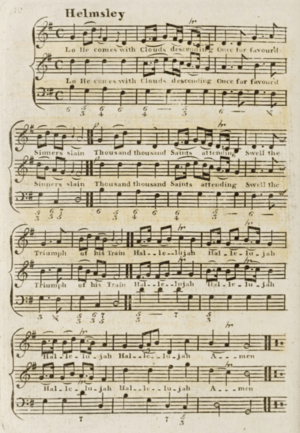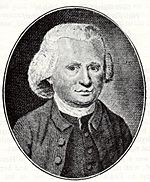Lo! He comes with clouds descending facts for kids
Quick facts for kids Lo! He comes with clouds descending |
|
|---|---|
 |
|
| Genre | Hymn |
| Written | 1758 |
| Text | John Cennick, Charles Wesley |
| Based on | Revelation 1:7 |
| Meter | 8.7.8.7.4.7 |
| Melody | "Helmsley" by Thomas Olivers, "Regent Square" by Henry Smart |
"Lo! He comes with clouds descending" is a famous Christian hymn. It was written by Charles Wesley (1707–1788). He based it on an older hymn by John Cennick (1718–1755). This hymn is often sung during Advent. Advent is the time before Christmas. The hymn talks about the Second Coming of Jesus Christ. It uses ideas from the Book of Revelation in the Bible. It also describes the Day of Judgment. In the 1800s, people thought it was one of the "Great Four Anglican Hymns." It is usually sung with a tune called Helmsley. This tune was first published in 1763.
About the Words
The words for this hymn started with John Cennick. His hymn was called "Lo! He cometh, countless Trumpets." It was published in 1752. Later, Charles Wesley changed Cennick's words a lot. He published his version in 1758. Some hymn books today use a mix of both versions.
The main idea for the hymn comes from the Bible. Specifically, it's from Revelation chapter 1, verse 7. This verse talks about Jesus Christ returning to Earth.
In the 1800s, this hymn was very popular. A survey in 1885 called Anglican Hymnology looked at 52 hymn books. These books were from Anglican churches around the world. The survey found that 51 of them included this hymn. It was considered one of the "Great Four Anglican Hymns." The others were 'All Praise to Thee, my God, this Night', 'Hark! The Herald Angels Sing', and 'Rock of Ages'.
The Music: "Helmsley"
The tune "Helmsley" is usually linked to Thomas Olivers. He was a Welsh Methodist preacher. He also wrote hymns.
How "Helmsley" Was Created
There's a story about how Olivers found the tune. People say he heard someone whistling it in the street. He then used that melody to create "Helmsley." The tune likely came from an old Irish song. That song was called "Guardian angels, now protect me."
A music expert named George Arthur Crawford wrote about this in 1900. He said: "The story goes that Thomas Olivers... was attracted by a tune which he heard whistled in the street." He then used it for the Advent hymn. The original song "Guardian angels" probably started in Dublin.
The tune "Helmsley" first appeared in print in 1765. It was in Wesley's Select Hymns with Tunes annexed. It was listed under the name "Olivers."
Some people thought the tune came from a dance called a hornpipe. This hornpipe was in a show called Golden Pippin around 1771. But the hymn tune was published earlier. So, it's more likely the hornpipe used the hymn tune. Or, both came from the same original song, "Guardian angels."
Another idea was that Thomas Arne wrote the tune. He was a famous composer. This was because it sounded a little like a song from his opera Thomas and Sally (1760). But the similarities are small. Also, the dates don't quite match up.
By 1763, the hymn words "Lo! He comes with clouds descending" were printed with the "Helmsley" tune. This was in Martin Madan's Collection of Psalm and Hymn Tunes. This book was used at the Lock Hospital. Madan's version combined Wesley's words with some of Cennick's.
Other Tunes for the Hymn
Sometimes, this hymn is sung with other tunes. These include "St Thomas," "Regent Square," "Westminster Abbey," "Kensington New," and "Cum Nubibus." The 1982 Lutheran Worship hymnal uses a more serious tune called Picardy.
Brooke Foss Westcott was a Bishop in 1901. He remembered that Queen Victoria once got upset. An organist played a different tune for the hymn at St George's Chapel, Windsor Castle. The Queen then asked that only "Helmsley" be played in the future.




